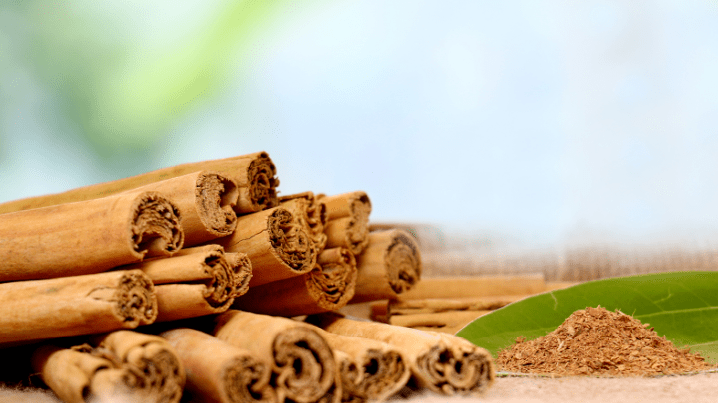Quick Peel is a versatile formulation for everything from sensitive, reactive skin, fragile capillaries, sluggish dull skin, acne, and early-stage rosacea, it is also a great choice for fungal acne. It uses pseudo heat to increase circulation, oxygenation and nutrient supply to the tissue. For quick and effective results, DMK Quick Peel can be used on many different skin conditions with outstanding results.
A key to Quick Peel’s success is the key ingredient of Cinnamon. Cinnamon is rich in plant compounds known as polyphenols, such as cinnamic acid, cinnamaldehyde, and various flavonoids. These boast anti-inflammatory and antioxidant properties that help fight cell-damaging free radicals.
Cinnamon has been used for thousands of years in Ayurvedic medicine to soothe aching joints and numb pain, because of its anti-inflammatory property. Cinnamon bark essential oil (CBEO) typically contains a very high amount of cinnamaldehyde and a small amount of eugenol, among many other aromatic compounds.
Researchers have suggested that cinnamon’s high cinnamaldehyde content may be responsible for its collagen-promoting effects, while its antioxidant properties may protect the skin from collagen-degrading free radicals. CBEO also significantly promotes type I collagen biosynthesis within dermal fibroblasts. Cinnamaldehyde is the major active component in the Cinnamon extract that induces type I collagen biosynthesis.[1]
Previous studies have indicated that CBEO and its major active component cinnamaldehyde may have promising anti-inflammatory properties. Chen et al. 2016 demonstrated using an animal model that trans‐cinnamaldehyde suppresses lipopolysaccharide‐induced inflammation.[2] The observed strong anti-inflammatory effect of Cinnamon Extract (CE) in the human skin disease model suggests that CE may be used for treating inflammatory skin conditions.
To date, several antimicrobial activities of cinnamon and its oils have been reported in various studies. For example, Matan et al. reported the effects of cinnamon oils on different bacterial (Pediococcus halophilus and Staphylococcus aureus), fungal (Aspergillus flavus, Mucor plumbeus, Penicillium roqueforti, and Eurotium sp.), and yeast species (Candida lipolytica, Pichia membranaefaciens, Debaryomyces hansenii, and Zygosaccharomyces rouxii), indicating that cinnamon is a natural antimicrobial agent.[3]
In fact, CE inhibited all the 17 biomarkers that were studied. It showed significant anti‐proliferative activity against the dermal fibroblast cells. CE also significantly inhibited the production of inflammatory cytokines such as monocyte chemoattractant protein‐1, interferon gamma‐induced protein 10, interferon‐inducible T‐cell alpha chemoattractant, and monokine induced by gamma interferon (MIG). Furthermore, CE significantly inhibited the production of vascular cell adhesion molecule‐1 (VCAM‐1) and intercellular cell adhesion molecule‐1. The levels of several tissue remodelling molecules, including epidermal growth factor receptor (EGFR), matrix metalloproteinase 1, and plasminogen activator inhibitor 1, were significantly decreased by CE. CE also significantly reduced the levels of macrophage colony‐stimulating factor, which is an immunomodulatory protein.
The inhibitory effect of CE on the production of tissue remodelling biomarkers in the highly inflamed skin model suggests that CE and cinnamaldehyde may be beneficial for wound healing. This might be, at least, partially attributed to their anti-inflammatory and antimicrobial properties. Moreover, CE showed significant anti‐proliferative activity against the skin cells used in the study. Genome‐wide gene expression analysis demonstrated that CE significantly modulated global gene expression and some signalling pathways. It was noted that many of the genes and signalling pathways affected by CE play critical roles in inflammation, immune response and DNA damage response. The overall inhibitory effect of CE suggests its potential in regulating the above mentioned biological processes.[4]
Furthermore, Cinnamon extract with water is also used in cosmetics since it contains aroma as well as important constituents that can soothe and heal the skin. It has terpenes as its constituents, which are believed to improve microcirculation of the skin, fight free radicals and enhance the skin tone. So, it is used to improve skin tone as well as microbial health of the skin.
References:
[1] https://www.ncbi.nlm.nih.gov/pmc/articles/PMC3569896/
[2] https://www.ncbi.nlm.nih.gov/pmc/articles/PMC5518441/#ptr5822-bib-0007
[3] https://www.ncbi.nlm.nih.gov/pmc/articles/PMC4003790/
[4] https://www.ncbi.nlm.nih.gov/pmc/articles/PMC5518441/

